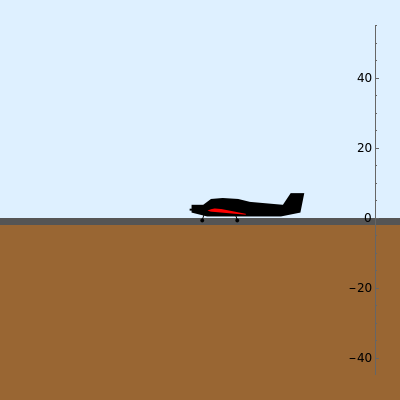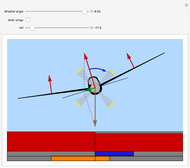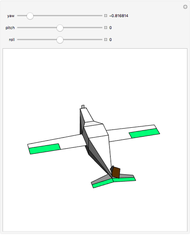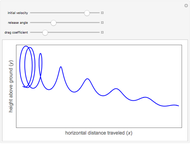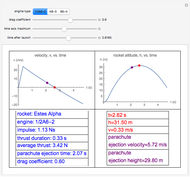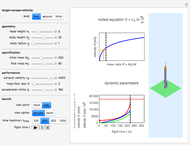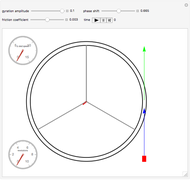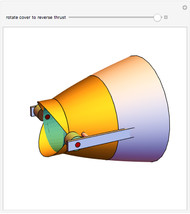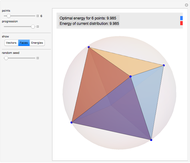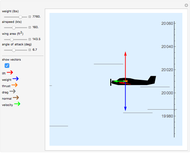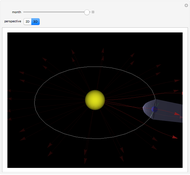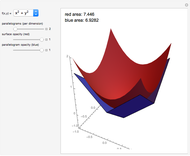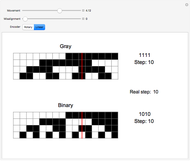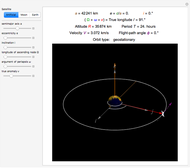The Physics of Flight

Requires a Wolfram Notebook System
Interact on desktop, mobile and cloud with the free Wolfram Player or other Wolfram Language products.
This Demonstration displays the basic forces that act on an aircraft in flight: lift, weight, thrust, and drag. With any given settings of the sliders, we can find the point of equilibrium (where all the forces will cancel out). Reducing the weight of the aircraft, traveling at a high velocity, increasing wing area, and finding the ideal angle of attack cause the aircraft to reach its maximum altitude (or absolute ceiling). In a real-life setting, this altitude is extremely difficult to reach, and to be safe an aircraft rarely attempts to fly near its absolute ceiling, but this Demonstration shows which factors influence the lift and drag forces on an aircraft.
[more]
Contributed by: Mark Peterson (August 2011)
Open content licensed under CC BY-NC-SA
Snapshots
Details
This Demonstration uses the formula  , where
, where  is the force of lift,
is the force of lift,  is air density,
is air density,  is velocity,
is velocity,  is reference area, and
is reference area, and  is the coefficient of lift, to find the altitude of equilibrium by setting the force of lift equal to the weight, then solving for the air density, and calculating the corresponding altitude. The coefficient of lift depends on the angle of attack and the shape of the airfoil, which is constant in this Demonstration. The coefficient of lift increases with the angle of attack up to the critical angle of attack (about 17 degrees here), after which the aircraft is considered to be stalled. Post-stall sustained flight is possible although very uncommon, because a stall usually occurs due to a slow airspeed or high
is the coefficient of lift, to find the altitude of equilibrium by setting the force of lift equal to the weight, then solving for the air density, and calculating the corresponding altitude. The coefficient of lift depends on the angle of attack and the shape of the airfoil, which is constant in this Demonstration. The coefficient of lift increases with the angle of attack up to the critical angle of attack (about 17 degrees here), after which the aircraft is considered to be stalled. Post-stall sustained flight is possible although very uncommon, because a stall usually occurs due to a slow airspeed or high  forces, not because the wing is mounted to the aircraft at a high angle.
forces, not because the wing is mounted to the aircraft at a high angle.
Similarly, the formula  is used to find the force of drag, where
is used to find the force of drag, where  is the coefficient of drag. Because there are several types of drag, including form drag and induced drag, the coefficient of drag typically decreases gradually until the angle of attack is around 6 degrees, then begins to increase sharply as the angle of attack is increased further.
is the coefficient of drag. Because there are several types of drag, including form drag and induced drag, the coefficient of drag typically decreases gradually until the angle of attack is around 6 degrees, then begins to increase sharply as the angle of attack is increased further.
Although it does not provide the maximum amount of lift or the least amount of drag, the ideal angle of attack is usually considered to be when the lift to drag ratio is at its highest. The maximum  is usually achieved when the angle of attack is just above the point of minimum drag, and is around 7 degrees in this case.
is usually achieved when the angle of attack is just above the point of minimum drag, and is around 7 degrees in this case.
Snapshot 1: an angle of attack with a high 
Snapshot 2: an angle of attack past the critical angle
Snapshot 3: a negative angle of attack
Permanent Citation
